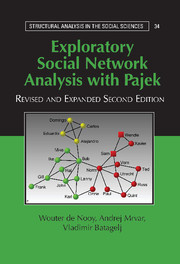Book contents
- Frontmatter
- Contents
- Figures
- Tables
- Preface to the Second Edition
- Preface to the First Edition
- Part I Fundamentals
- Part II Cohesion
- 3 Cohesive Subgroups
- 4 Sentiments and Friendship
- 5 Affiliations
- Part III Brokerage
- Part IV Ranking
- Part V Roles
- Appendix 1 Getting Started with Pajek
- Appendix 2 Exporting Visualizations
- Appendix 3 Shortcut Key Combinations
- Glossary
- Index of Pajek and R Commands
- Subject Index
4 - Sentiments and Friendship
from Part II - Cohesion
Published online by Cambridge University Press: 05 June 2012
- Frontmatter
- Contents
- Figures
- Tables
- Preface to the Second Edition
- Preface to the First Edition
- Part I Fundamentals
- Part II Cohesion
- 3 Cohesive Subgroups
- 4 Sentiments and Friendship
- 5 Affiliations
- Part III Brokerage
- Part IV Ranking
- Part V Roles
- Appendix 1 Getting Started with Pajek
- Appendix 2 Exporting Visualizations
- Appendix 3 Shortcut Key Combinations
- Glossary
- Index of Pajek and R Commands
- Subject Index
Summary
Introduction
In the preceding chapter, we discussed several techniques for finding cohesive subgroups within a social network. People who belong together tend to interact more frequently than people who do not. In the current chapter, we extend this idea to affective relations that are either positive or negative, for instance, friendship versus hostility, liking versus disliking. We expect positive ties to occur within subgroups and negative ties between subgroups.
Hypotheses about patterns of affective relations stem from social psychology, and they are widely known as balance theory. First, we introduce this theory and discuss how it was incorporated in network analysis. Then, we apply it to affective relations, that is, social relations that are subjective and mental rather than tangible.
Balance Theory
Social psychology is interested in group processes and their impact on individual behavior and perceptions. In the 1940s, Fritz Heider formulated a principle that has become the core of balance theory, namely, that a person feels uncomfortable when he or she disagrees with his or her friend on a topic. Figure 42 illustrates this situation: P is a person, O is another person (the Other), and X represents a topic or object. P likes O, which is indicated by a positive line between P and O; however, they disagree on topic X because P is in favor of it (positive line), whereas O is opposed to it (negative line). Note the convention of drawing negative ties as dashed lines, which is also adopted in Pajek.
- Type
- Chapter
- Information
- Exploratory Social Network Analysis with Pajek , pp. 97 - 115Publisher: Cambridge University PressPrint publication year: 2011

